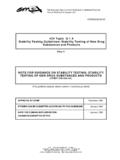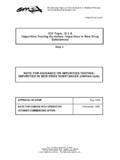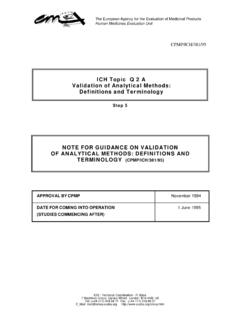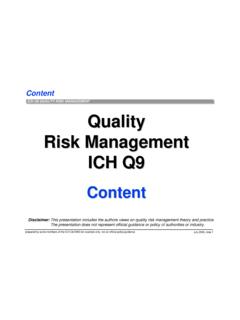Transcription of 5.10. CONTROL OF IMPURITIES IN SUBSTANCES FOR ...
1 EUROPEAN PHARMACOPOEIA IMPURITIES in SUBSTANCES for pharmaceutical use01/2005 CONTROL OF IMPURITIESIN SUBSTANCES FORPHARMACEUTICAL USEP reambleThe monographs of the European Pharmacopoeia onsubstances for pharmaceutical use are designed to ensureacceptable quality for users. The role of the Pharmacopoeiain public health protection requires that adequate controlof IMPURITIES be provided by monographs. The qualityrequired is based on scientific, technical and concerning IMPURITIES are given in specificmonographs and in the general monographSubstancesfor pharmaceutical use (2034).
2 Specific monographsand the general monograph are complementary: specificmonographs prescribe acceptance criteria for impuritieswhereas the general monograph deals with the need forqualification, identification and reporting of any organicimpurities that occur inactive thresholds for reporting, identification and qualificationcontained in the general monographSubstances forpharmaceutical use (2034)apply to all related , if a monograph does not contain a relatedsubstances test based on a quantitative method, any newimpurities occurring above a threshold may be overlookedsince the test is not capable to detect those provisions of the Related SUBSTANCES section of thegeneral monographSubstances for pharmaceuticaluse (2034), notably those concerning thresholds, do notapply to excipients; also excluded from the provisionsof this section are: biological and biotechnologicalproducts; peptides; oligonucleotides; radiopharmaceuticals.
3 Fermentation products and semisynthetic products derivedtherefrom; herbal products and crude products of animal andplant origin. Although the thresholds stated in the generalmonograph do not apply, the general concepts of reporting,identification (wherever possible) and qualification ofimpurities are equally valid for these for the elaboration of monographs of the EuropeanPharmacopoeiaEuropean Pharmacopoeia monographs are elaborated onsubstances that are present in medicinal products that havebeen authorised by the competent authorities of Parties totheEuropean Pharmacopoeia.
4 These monographs do not necessarily cover all sources ofsubstances for pharmaceutical use on the world and inorganic IMPURITIES present in those substancesthat have been evaluated by the competent authorities arequalified with respect to safety at the maximum authorisedcontent (at the maximum daily dose) unless new safety datathat become available following evaluation justify Pharmacopoeia monographs on substancesfor pharmaceutical use are elaborated by groups ofexperts and working parties collaborating with nationalpharmacopoeia authorities, the competent authorities formarketing authorisation, national CONTROL laboratories andthe European Pharmacopoeia laboratory.
5 They are alsoassisted by the producers of the SUBSTANCES and/or thepharmaceutical manufacturers that use these of IMPURITIES in SUBSTANCES for pharmaceutical useThe quality with respect to IMPURITIES is controlled by a set oftests within a monograph. These tests are intended to coverorganic and inorganic IMPURITIES that are relevant in viewof the sources of active SUBSTANCES in authorised for pharmaceutical use (2034)andgeneral Residual solvents . The certificate ofsuitability of a monograph of the European Pharmacopoeiafor a given source of a substance indicates the residualsolvents that are controlled together with the specifiedacceptance criteria and the validated CONTROL method wherethis differs from those described in general and CONTROL of residual on organic chemicals usually have a testentitled Related SUBSTANCES that covers relevant organicimpurities.
6 This test may be supplemented by specific testswhere the general test does not CONTROL a given impurityor where there are particular reasons (for example, safetyreasons) for requiring special a monograph has no Related SUBSTANCES (orequivalent) test but only specific tests, the user of asubstance must nevertheless ensure that there is suitablecontrol of organic IMPURITIES ; those occurring above theidentification threshold are to be identified (whereverpossible) and, unless justified, those occurring abovethe qualification threshold are to be qualified (see alsounder Recommendations to users of monographs of activesubstances).
7 Where the monograph covers SUBSTANCES with differentimpurity profiles, it may have a single related SUBSTANCES testto cover all IMPURITIES mentioned in the IMPURITIES section orseveral tests may be necessary to give CONTROL of all knownprofiles. Compliance may be established by carrying outonlythetestsrelevanttotheknownimpurit yprofileforthesource of the for CONTROL of IMPURITIES may be included inthe Production section of a monograph, for example wherethe only analytical method appropriate for the CONTROL ofa given impurity is to be performed by the manufacturersince the method is too technically complex for general useor cannot be applied to the final drug substance and/orwhere validation of the production process (including thepurification step)
8 Will give sufficient IMPURITIES section in a monograph includes IMPURITIES (chemical structure and name wherever possible), which areusually organic , that are known to be detected by the testsprescribed in the monograph. It is based on informationavailable at the time of elaboration or revision of themonograph and is not necessarily exhaustive. The sectionincludes specified IMPURITIES and, where so indicated, otherdetectable impuritieshave an acceptance criterion notgreater than that authorised by the competent detectable impuritiesare potential IMPURITIES witha defined structure but not known to be normally presentabove the identification threshold in SUBSTANCES usedin medicinal products that have been authorised by thecompetent authorities of Parties to the Convention.
9 They an impurity other than a specified impurity is found inan active substance it is the responsibility of the user of thesubstance to check whether it has to be identified/qualified,depending on its content, nature, maximum daily doseand relevant identification/qualification threshold, inaccordance with the general monograph onSubstances forpharmaceutical use (2034), Related SUBSTANCES (1) IMPURITIES in SUBSTANCES for pharmaceutical useEUROPEAN PHARMACOPOEIA should be noted that specific thresholds are applied tosubstances exclusively for veterinary of the test for related SUBSTANCES in themonographs on active substancesA specific monograph on a substance for pharmaceutical useis to be read and interpreted in conjunction with the generalmonograph onSubstances for pharmaceutical use (2034).
10 Where a general acceptance criterion for IMPURITIES ( any other impurity , otherimpurities , any impurity )equivalent to a nominal content greater than the applicableidentification threshold (see the general monograph onSubstances for pharmaceutical use (2034)) is prescribed,this is valid only for specified IMPURITIES mentioned in theImpurities section. The need for identification (whereverpossible), reporting, specification and qualification ofother IMPURITIES that occur must be considered accordingto the requirements of the general monograph. It is theresponsibility of the user of the substance to determinethe validity of the acceptance criteria for IMPURITIES notmentioned in the IMPURITIES section and for those indicatedas other detectable following examples are given as an aid in theinterpretation of acceptance criteria for IMPURITIES in specificmonographs.




